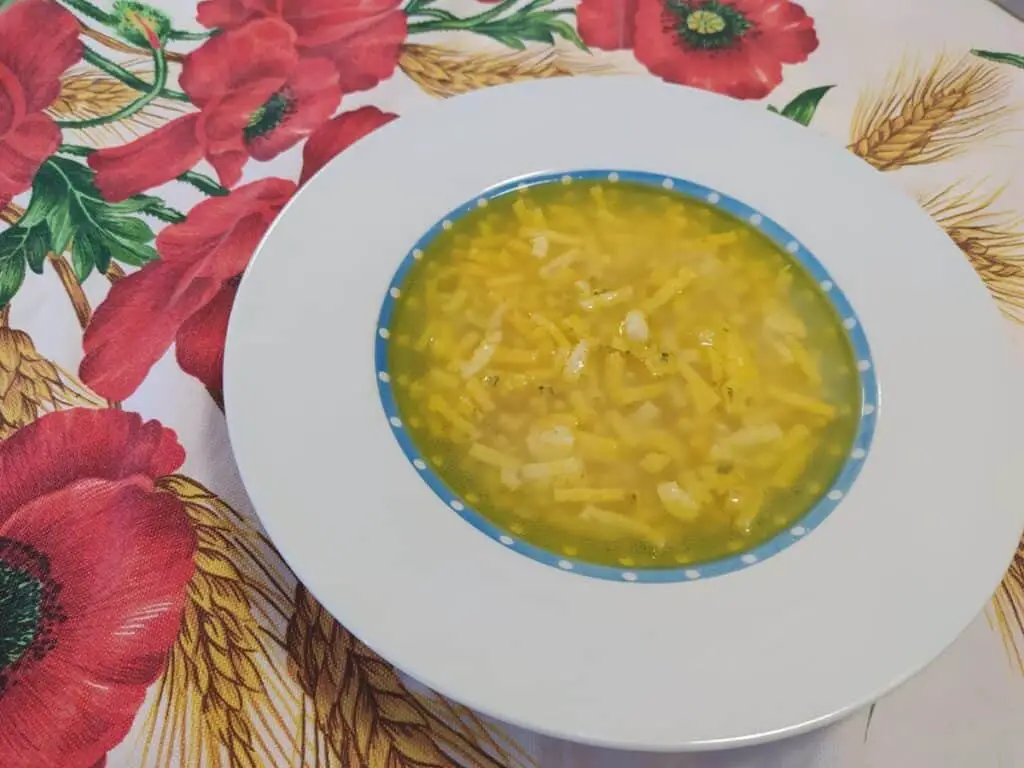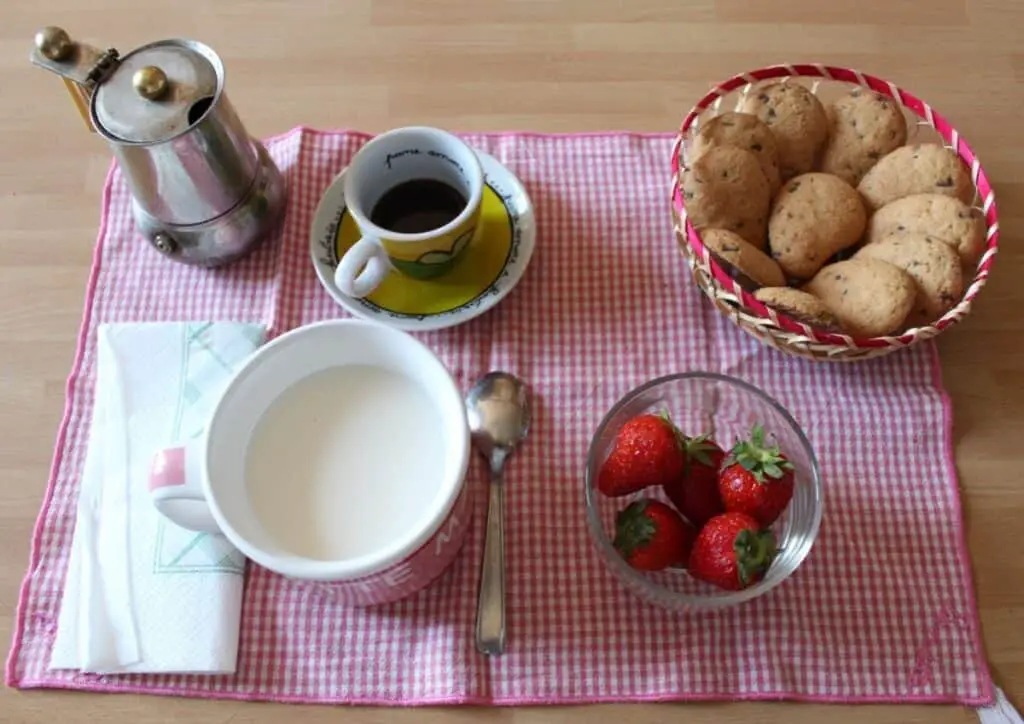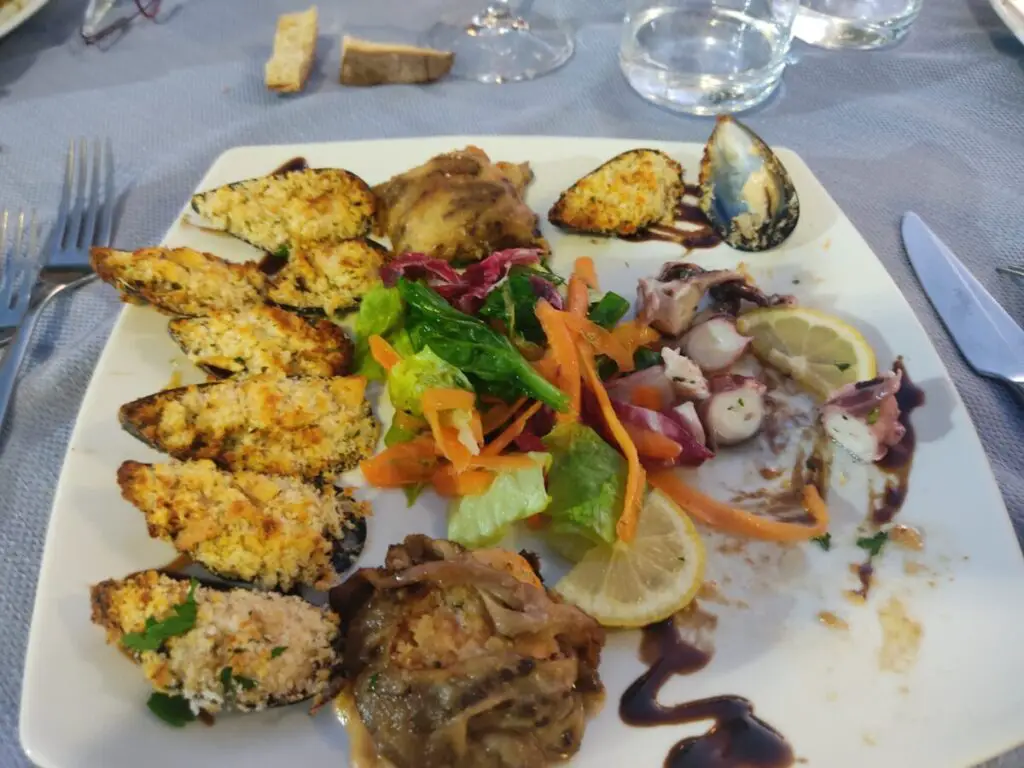You may have heard that mealtimes in Italy are important, and you might be wondering what the traditional dinner time is in Italy.
This detailed post will answer all your questions about dinner time in Italy, mealtime habits and their origins.
Keep reading to find out more
Most Italians eat dinner between 8 pm and 9 pm, although dinner in northern Italy can be slightly earlier, around 7pm. Restaurants may serve dinner as late as 10:30 pm, but you won’t be able to sit down for dinner before 7 pm. Food is a very important part of the Italian culture, and Italian mealtime habits originate from an interaction of the Italian climate, structure of the workday and centrality of family.
What time do Italians have dinner? (I asked six Italian friends)
I asked six Italian friends, all from central Italy, what time they have dinner. The majority of them said that they eat dinner between 8 pm and 9 pm, one said 8:30 pm and another said that she eats dinner between 7 pm and 9 pm.
Even in such a small sample of people, it is clear that most Italians choose to eat dinner between 8 and 9pm.

Differences in dinnertime between northern and southern Italy
Dinnertime in northern Italy is earlier than in southern Italy. In northern Italy, some Italians eat dinner as early as 7 pm, while in southern Italy 8 pm is usually the earliest that Italians have dinner.
These differences in dinnertime between northern and southern Italy are due to differences in weather and levels of industrialisation between the northern and southern parts of the country.
Southern Italy tends to get very hot in the summer, so people normally wait until the temperature cools down before having dinner, so that they can eat more comfortably.
In southern Italy during summer, dinner can get quite late sometimes, and people at home might delay it until as late as 10 pm. Italians tend to go to bed very late, but school holidays in Italy run from early June to early September, and so children don’t need to wake up early in the morning.
The north of Italy is the most industrialised part of the country. Work tends to be fast-paced, especially in the larger industries, and the working lifestyle, at least in some workplaces, is a little closer to that of the US or UK.
People who work in very fast-paced environments in northern Italy, especially in big cities where there is a lot of traffic, tend to have a light lunch and stay close to the office at lunchtime. This means that, when people get home from work, they are hungry, and this is another reason why dinnertime in northern Italy is earlier than in southern Italy.
Dinnertime in central Italy tends to be somewhere in between the northern and southern parts, usually between 8 pm and 9 pm.
It is common practice to wait until the sun goes down to have dinner in Italy, both in the north and in the south.
During the summer months in Italy, the sun goes down between 8 pm and 8:30 pm . This is partly due to tradition and partly due to the nice weather, which means that people spend a lot of time doing outdoor activities when it’s light and they don’t return home to eat with their families until the sun is gone.
Why do Italians eat dinner so late?
Italian mealtimes are determined by three main factors:
- Italy’s climate
- The structure of the workday in Italy
- The centrality of family in the Italian culture
The late dinner time of Italians is linked, historically, to the country’s climate because, during the summer, it is too hot to have dinner early, and so usually people wait until it cools down and the sun stops shining to eat, so that the temperature will be more comfortable.
Another factor that determines Italian dinner time is the structure of the workday and business opening and closing times. Most Italian businesses close in the central part of the day, and re-open mid-afternoon. This has a knock-on effect on how late Italians finish work in the evening.
Lunch is seen as an important meal in the day, on the same level as dinner, not secondary to it. Working parents, children, and very often grandparents, come together for lunch in the great majority of cases. Italians go back to work mid-afternoon after a long lunch break, and then stay at work until about 7:30 pm.
Meals are seen by Italians as times for family and friends to gather together. Mealtimes are, for Italians, a way of sharing lives with the people they are close with.
The structure of the Italian workday means that lunch in Italy is not a quick meal and, in fact, in terms of calorie content, lunchtime foods tend to be much more substantial than dinnertime foods: lunchtime in Italy is usually a two-course meal consisting of pasta, sometimes with fatty sauces, as a first course, but also a second course.

Because Italian lunches are large, and there is often a a snack in between lunch and dinner, Italians don’t tend to get hungry until later in the day, and so dinner time gets pushed back to later in the evening.
Italians are usually hungry by the time they get to lunch because the Italian breakfast is light and carbohydrates-rich. Often Italians just have an espresso with a cookie or skip breakfast altogether.
You can see how the Italian weather, structure of the workday and culture, all interact to affect mealtimes.
When is dinner served in restaurants?
As a general rule, restaurants in northern Italy open at around 7pm both in the winter and the summer season. In southern Italy restaurants start serving dinner from about 8pm. It is highly unlikely that you’ll be able to sit down for dinner at a restaurant in Italy before 7pm.
Lunch in restaurants is served between around 12:00 – 12:30 pm and 2:30 pm. After that, restaurants close for a break and re-open a little later, ready to start serving dinner from about 7 pm at the earliest.
Is there a difference in Italian mealtimes between the weekend and the weekdays?
There are no big changes in mealtimes between the weekend and weekdays in Italy. Most children and teenagers usually finish at school by 1:30pm at the latest, and then they go home and spend the afternoon doing homework.
Spending some of the afternoon at school is a possibility, as there is an option to voluntarily opt-in for lunch and afternoon at school for one to four days of the week, but it’s not very common for parents to choose this option.
The majority of Italians have a long lunch break, because many businesses close at about 12:30 and re-open at about 4:30 in the afternoon until about 8 pm. This gives parents a chance to go back home, serve lunch and have lunch with their families and spend some time with them before they go back out to work.
This means that lunchtime and dinnertime for Italians stay the same between the weekdays and the weekend.
Dinnertime habits in Italian homes
TV dinners and, generally, eating in front of the TV and/ or off a tray is extremely rare for Italian families. Some families might have the TV on in the background while sitting around the table, but it’s important to stress that the TV being on doesn’t preclude conversation.
Conversation is the main highlight of Italian families eating meals together. Between family members talking, often all at the same time, and sometimes the TV in the background, family meals in Italy can often be quite noisy!
Staggered eating of different family members in Italy is also very rare. Children eat with their parents from a very young age. If a child is under one year old, they might be fed separately but they are often at the table with their parents during meals.
The Italian language around children’s eating doesn’t use phrases like “feeding a child” or “the children have been fed” but, rather “let’s eat” or “we have eaten”, stressing that, rather than being seen as “feeding”, food is something for all the family to take part in together, regardless of age.
Sometimes, young Italian children go to bed quite late because of the Italian dinnertime habits.. Italian children rarely go to bed before 9:30 pm or 10 pm, sometimes even later, even on school days.

You may notice that the tradition of eating all together as a family is more pronounced in central and southern Italy than northern Italy. Southern Italy has a slightly stronger family tradition. Families also tend to be larger there and family members are more involved in each others’ lives (for better or worse!)
This is partly due to the higher level of industrialisation in northern Italy, and also to the pervasiveness of the Catholic religion, meaning that divorce rates are low in Italy generally, but even lower in southern Italy.
How common is it for Italians to ask someone to stay for dinner?
It is very common for Italians, when a friend or neighbour or school friend of the children visits, to ask them to stay for dinner.
Having someone stay for an informal, everyday, dinner is a common occurrence because there is a very strong community spirit in Italy, so neighbours are often also friends, for example, and are often round each others’ house.
Italians are comfortable just sharing with their guests everyday foods that they would normally eat, without standing on ceremony.
The importance of mealtimes in the Italian culture
The Italian culture places a lot of emphasis on food, so a lot of thought goes into when to eat, what to eat and how to eat, and food is often part of everyday conversations.
The time that a meal is eaten counts a lot for Italians. To give you an idea in practice, often the thought process for a typical Italian is not “I will eat now because I feel hungry”, but rather “I eat because it’s dinnertime/ lunchtime”.
The importance of mealtimes in Italy is obviously closely related to how central family is in the Italian culture: there needs to be a routine and regular times around meals in order for mealtimes to be a dedicated space for all the family to gather.
Mealtimes and the routine around food, however, become so ingrained in people’s daily lives from their early childhood into their teen years, that the typical Italian tends to maintain that routine and centrality of mealtimes even if they then happen to have no family or live on their own.
These are things I often hear when speaking to Italian family and friends that illustrate the mindset of a typical Italian around mealtimes:
- “It’s already 1:30, it’s time to eat”
- “I haven’t had my dinner yet”
- “Have you eaten yet?” or “Have you had lunch yet?” or “Have you had dinner yet?”
Mealtimes are important within the day of an Italian, more than in other cultures. They are not just for feeding, but they are used to mentally divide the day and mark certain periods, or phases, within the daily routine.
The question “have you eaten yet?” is not necessarily to ask if you are hungry or well fed, but more to find out where you are in the unfolding of your day and what you are up to.
Why are mealtimes important in Italy?
As a family-oriented culture, mealtimes for Italians mark different periods in the unfolding of the day, and they are important times for family to gather.
Italy industrialized relatively late compared to other countries, and so it has been possible for Italians to keep gathering with their families at mealtimes through the decades, because people’s work patterns and type of work (for example, agriculture and small-scale manufacturing) has allowed them the time to gather both at lunch and at dinner.
Nowadays, although the organization of the work day is gradually becoming more globalized, the importance of mealtimes still permeates the Italian culture.
In Italy, habits and traditions are easily preserved from one generation to the next, because those habits are nurtured within families, and family in Italy is at the centre of cultural life. It shapes how a person is, what they do and how they do it.
Differences between Italy and other countries in general mealtime culture
Eating lunch at your desk
It is rare to see people eating lunch at their desks in Italy. Although lunch tends to be quicker in larger businesses in the more industrialised cities, many businesses close altogether for a longer lunch break.
The main reason for eating lunch at home in Italy is that, during the summer months, the central part of the day is too hot to work.
Now that air conditioning is more widespread, the tradition of a longer lunch break has remained, and the great majority of Italian workplaces don’t have a staff kitchen that people can use to prepare a light lunch so that they can eat in the office.
Eating habits when cohabiting
People in the same household, whether they are flatmates, or partners, or family tend to eat meals together, even at the initial stages of their friendship.
Italians don’t usually eat on their own or away from the dining room, and if someone got food and went and ate it by themselves, this would be seen as a little strange.
Mealtimes in Italy are seen as times where people who live in the same household gather together and sit around the table.
Dedicated foods for certain times of the day
For Italians, there are certain specific food that are considered appropriate for certain times of the day but not others.
Lunchtime is mainly for pasta, meat, vegetables or sandwiches (if you are not at home), all staple foods. And so is dinner, although dinner is more for soups and protein-based foods. Snacks are usually very carb-rich.
Eating staple-type foods in the middle of the afternoon or the middle of the morning, outside of what are considered to be main mealtimes, would be seen as a little strange by an Italian.
What are other mealtimes in Italy?
Other mealtimes in Italy are as follows:
- Breakfast
Breakfast time is very flexible, and depends on people’s life circumstances, primarily whether they go to work or school. Italian breakfast can be at any time between 6:30 am to 11 am. Some bars are open as early as 5:30 am and will serve breakfast then to people in transit to go to work.
Bars serve the typical Italian breakfast, croissant and cappuccino or espresso, at any time, but, from about 11am, you’ll see that there is a lot less choice of croissants, or sometimes no croissants at all.
- Lunch
Lunchtime in Italy is any time between 12:30 pm and 2 pm. Depending on lifestyle (whether people are commuting or coming home late from school), lunch can be a little later, but usually not past 2:30 pm. By 2 pm most restaurants stop serving lunch.
- Dinner
Dinnertime in Italy is any time between 7 pm (although this is classed as early, and more of an exception) to 10 pm. In very touristy places, especially in the summer, you might find that some busy restaurants serve dinner even later than 10 pm, but past 10:30 pm is usually considered an exception.
- Snacks
Italians sometimes have a mid-morning snack, which can be any time between 10 am and 11:30 am, and an afternoon snack, which can be any time between 4 pm up to as late as 6:30 pm.
Bars serve a variety of snacks and drinks all day round, but certain pizza bars, where pizza slices can be bought, are reserved for afternoon snacks and serve pizza between 4 pm and 6:30 pm. After that, it’s considered dinner time and you would go to a restaurant for dinner, rather than a bar for a snack.





